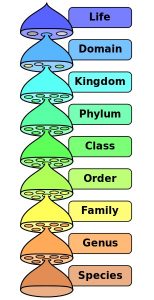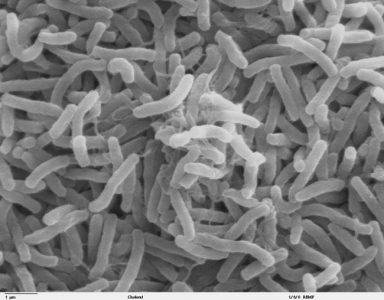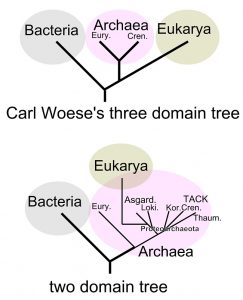Domain Definition
In biology, a domain refers to the largest of all groups in the classification of life. There are currently 3 agreed groups at this level, the Archaea domain, Bacteria domain, and Eukarya domain. Each domain contains a collection of organisms with similar properties and evolutionary histories, as scientists have organized them. It should be noted that while the three domain system is widely accepted and taught, it has been contested by a number of scientists. The supposed relationships between the three domains is discussed below.
Domain in the Tree of Life
In the most widely accepted theme of the organization of life, a domain is the first subdivision, as seen in the image below.
A domain is then further broken up into kingdoms. In the domain Eukarya, for instance, there are four kingdoms: Animalia, Plantae, Fungi, and Protista. Each of these kingdoms is then broken down into smaller groups, all the way down to individual species.
The Three Domains
Archaea
The Archaea are a domain of bacteria-like organisms, but they have a distinct biochemistry which distinguishes them from bacteria. While they still have bacteria-like DNA and no organelles, they also have several differences which put them into a completely different domain. Their cell walls, and the RNA they produce, are significantly different from that found in the domain Bacteria.
The organisms found in the domain Archaea are often extremophiles. These organisms thrive in environments which other organisms find hostile. This could be a highly salty environment, one of high or low temperature, or even one with chemicals that are toxic to other organisms. While organisms in the domain Archaea were often considered distantly related to bacteria because of their weird tendencies, other scientists have hypothesized that they are more closely related to the organisms in the domain Eukarya.
Bacteria
Organisms in the domain Bacteria are also prokaryotes, having no distinguished organelles or membrane-bound nucleus. The domain Bacteria is also possibly the largest domain, containing possibly millions of unknown and unrecorded specimens. These small, single-celled organisms live almost everywhere, and are the size of most eukaryotic organelles. They contain their DNA in a small ring, and carry out all the functions of life within their single cytoplasmic space. As seen in the scanning electron micrograph below, these bacteria can be quite small. Each bacterium in the image below is roughly 1 micrometer long.
While there are millions, if not billions of species of bacteria, there are a handful that are significant to humans. For instance, many of the organisms living in your gut helping you digest you food come from this domain. We need many bacteria for the vitamins and nutrients they produce. However there are several species, such as the bacteria which cause cholera or meningitis, which are highly detrimental to human health. Even the plague, which has killed off massive amounts of the human population throughout history, was caused by organisms in this domain.
Eukarya
The domain Eukarya represents, well, everything else. The organisms in this domain are eukaryotic, meaning they have a membrane bound nucleus and organelles. In separating different tasks of life into these membrane-bound chambers, eukaryotes are able to increase their efficiency and host a different set of chemical reactions. For instance, mitochondria are energy-transferring organelles which enable organisms in this domain to undergo aerobic respiration. This allows them to process glucose, a necessary sugar for life, much more efficiently. As such, the organisms in the domain Eukarya have expanded to a large number of forms.
The eukaryotes include everything with organelles and a nucleus. This means that the microscopic amoeba and the largest animal on the planet, the blue whale, are both in this domain. Plants and fungi also share this domain. This may give a scale for how variable a domain can be. While it is easy to demonstrate within this domain because the differences are largely physiological, each domain has this much variability within it. The other domains, Bacteria and Archaea, contain largely biochemical variability, as their physiological variability is limited by being unicellular.
Relationships between the Three Domain Groups
Scientists are constantly debating and reorganizing the tree of life, based on new evidence. Several different theories have emerged in recent decades about the exact relationship between each domain. Two highly accepted theories can be seen in the image below.
In the 1990’s Carl Woese and associates described the three domain system, which is seen in the top image. Based on genetic and physiological information, the researchers concluded that there were likely three main groups of life, with the Archaea being more closely related to the Eukarya than the Bacteria. This can be contrasted to the Eocyte hypothesis, which posits that the Eukarya actually arose as a subdivision of the Archaea, blurring the lines between the groups. This hypothesis is also backed by genetic evidence, so it is unclear which hypothesis is correct.
Not Included in the Three Domain System
Neither of the above approaches include viruses or prions in the classification scheme for life. Many scientists do not consider these things to be living, as viruses hijack a cell’s machinery to replicate itself, while prions are misfolded proteins which somehow cause other proteins to fold incorrectly. Both of these genetically-based molecules have a means for reproduction, which is why many scientists consider them “living” for classification purposes. Several alternate theories including these groups into the domain system have been proposed, often creating new domains for each group.
Quiz
References
- Brusca, R. C., & Brusca, G. J. (2003). Invertebrates. Sunderland, MA: Sinauer Associates, Inc.
- Cain, M. L., Bowman, W. D., & Hacker, S. D. (2008). Ecology. Sunderland, MA: Sinauer Associates, Inc.
- Feldhamer, G. A., Drickamer, L. C., Vessey, S. H., Merritt, J. F., & Krajewski, C. (2007). Mammology: Adaptation, Diversity, Ecology (3rd ed.). Baltimore: The Johns Hopkins University Press.



